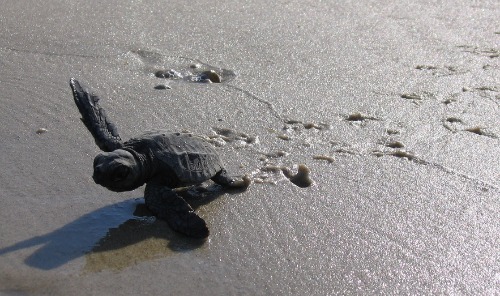Part hospital, part stud farm, the Israeli Sea Turtle Rescue Center at Michmoret, a few miles north of Netanya on the Mediterranean coast, is playing a vital role in protecting one of the world’s most endangered species.
All eight species of sea turtles are in danger of global extinction. Although this ancient reptile has existed for more than 150 million years, the past century has seen a sharp worldwide decline in its numbers. The two species that still survive in the Mediterranean – the green turtle and the loggerhead – may not be around much longer.
According to Yaniv Levy, manager of the rescue center, some 2,000 to 3,000 turtles nested along Israel’s shores at the turn of the previous century. Now the numbers are estimated at about 180 loggerheads and fewer than 20 green turtles, and he estimates that only 10 green females in Israel are capable of egg laying.

“We want to double this figure,” he tells ISRAEL21c.
Due to ongoing conservation efforts, the loggerhead population has begun to pick up. “The results of our efforts over the past two decades have been impressive – but we still have to fight to save every turtle,” says Levy.
Manmade problem, manmade solutions
The turtles face a gamut of manmade dangers: pollution, plastic bags and other seaborne litter; outboard motors and fishing nets; jeeps hurtling along beaches. About 50 injured turtles are brought to the Rescue Center every year, most of them hurt by human activity. According to Levy, the success rate in saving injured reptiles is about 65 percent.
“We treat injured turtles and return them to the sea, gather and incubate eggs before returning the hatchlings to the beaches, raise public awareness of the issue and help preserve the coastline and establish coastal nature reserves,” Levy explains.
Before being released, each saved turtle is outfitted with a satellite transmitter that allows researchers to track their migration routes as they make their way along the North African Mediterranean coastline. Their individual stories, and a map displaying their whereabouts, can be traced online.
For more than two decades, Israel National Nature and Parks Authority rangers have patrolled the Mediterranean coastline during hatching season, transferring eggs from nests to protected hatcheries. To date, at least 50,000 hatchlings have been released to protected sections of beach. Young turtles’ low survival rate — only one in every 100 hatchlings lives to reach reproductive age – means that every egg saved can have an impact.
Building a breeding ground
The 30 turtles cared for at the center since 2002 in individual seawater tanks will form the basis of its breeding stock once they reach sexual maturity in a couple of years. After the turtles mate, Levy and his staff intend to provide an artificial beach on which the females can lay their eggs. Then they plan to relocate the eggs to nature reserves along the Israeli coast, where the hatchlings will be greeted in their natural environment.

Thanks to pressure from environmentalists and the parliament’s Green Caucus, the Knesset has in recent years passed a series of laws to protect Israel’s beaches.
It is now illegal to build any structure within 100 meters of the Mediterranean coastline. Light from restaurants, banquet halls and nightclubs no longer disorients the young hatchlings, sending them in the wrong direction. Legislation has also outlawed driving vehicles on the beaches – a real threat to nesting spots and the hatchlings as they make their way to the water over a period of one to four days.
Volunteers are critical
The Rescue Center operates on a shoestring budget and employs only Levy and one other worker, backed by some 60 regular volunteers. “We rely greatly on people’s good nature, and usually act in response to people who spot a turtle in distress,” says Levy.
Once the necessary funding is found, the center is due to be relocated from its present premises at the Mevo’ot Yam marine boarding school to a new site a couple of kilometers south, near the Alexander Stream.

“We can’t stay here much longer – this facility is far too small. We lack sufficient access to seawater, and need more — and larger — water tanks for the turtles. Hopefully, we’ll be there two years from now,” says Levy.
His research forms an integral part of the annual State of the World’s Sea Turtles (SWOT) report, and the sea turtle website that unites experts worldwide. The center also cooperates with the UN-affiliated International Union for Conservation of Nature’s marine turtle specialist group for the Mediterranean region.
“We are part of the global approach to the problem,” Levy says. “We can slow down the extinction process, but probably not stop it altogether as long as humankind continues to behave as it does.”
Story by Daniel Ben Tal. Video by Jonathan Amerikaner.












